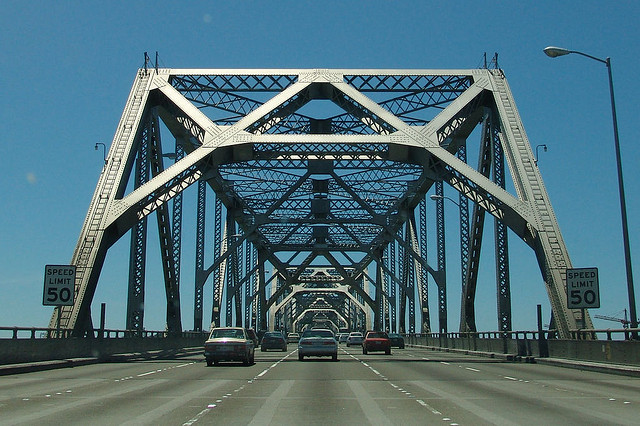
I had signed up to go out to the old eastern span of the Bay Bridge this morning to witness what Caltrans had advertised as the beginning of the massive structure's demolition. The agency has said the old bridge, notorious for its failure in the 1989 Loma Prieta earthquake, will be mostly gone within a year; the full demolition project, down to the "mud line" beneath the surface of the bay, will take three years. But last night, Caltrans said the deconstruction project will be delayed for awhile as contractors finish work on measures to prevent debris from falling into the bay waters. It's likely the taking-apart process will commence by next week.
But the prospect of the eastern span being taken down — without explosives, if you were wondering — got me thinking about major Bay Area demolition events of the past. I don't want to use the term too broadly in a region where nature has carried out destruction on a grand scale. Exhibits include the 1906 earthquake and fire, Loma Prieta and the Oakland Hills fire, among many others.
Still, there's something captivating both about seeing what we've built get taken down and in viewing others' fascination with the process. I once went to Las Vegas to witness the destruction of the once-iconic Stardust Hotel, and watching the crowd's anticipation and reaction was almost as fun as hearing the exploding dynamite and scurrying away from the billowing cloud of concrete dust that rolled down the Strip.
Here's a brief list — you might have other local demolitions in mind — of great moments in local structure removal:
1. Sea Cliff sinkhole (1995): I put this at the top of my list because it was shown on live TV. And no, it was not a planned demolition. In December 1995, a storm sewer near 25th Avenue and Lake Street broke during a major winter storm. The water rushing from the sewer excavated a giant sinkhole that swallowed a mansion. Here's how the Associated Press described the scene: "A three-story house in a neighborhood of million-dollar homes toppled into an enormous sinkhole and broke apart in a spray of timbers, walls and ceilings. ... A neighbor's garage also dropped into the hole, and at least seven other houses in San Francisco's exclusive Sea Cliff neighborhood were evacuated, including the childhood home of photographer Ansel Adams, which was built in 1902." And here's video of the collapse:
2. The Embarcadero Freeway (1989): The Loma Prieta earthquake was a disaster and a tragedy, destroying dozens of residences and killing more than 60 people, most of whom perished in the collapse of West Oakland's Cypress Freeway. But the quake did bestow one long-term gift: It damaged San Francisco's Embarcadero Freeway so badly that the city had little choice but to tear down the double-deck structure that had walled off the Ferry Building and the rest of the northeastern waterfront. The demolition led eventually to creation of today's more welcoming (if often congested) Embarcadero.
